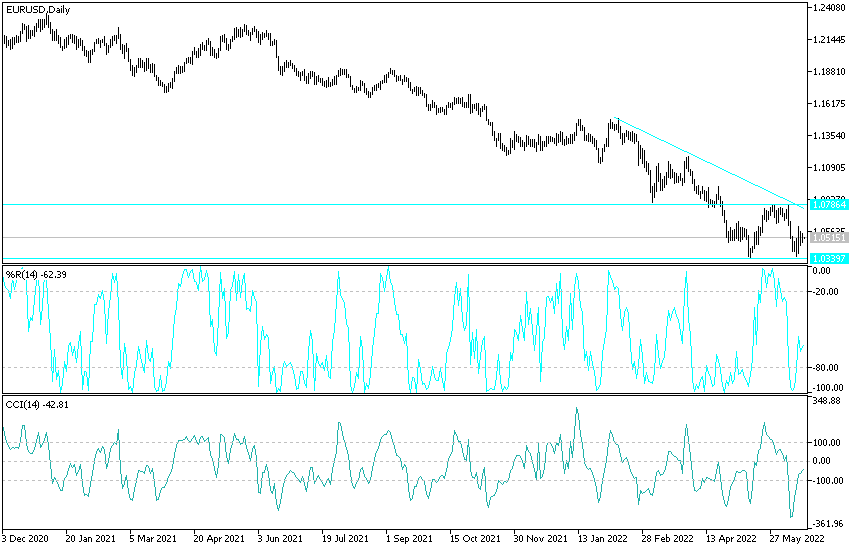During last week's trading, the EUR/USD exchange rate rose again from the edge of a five-year low last week. With escalating local headwinds and technical resistance looming almost just above the market, the euro could struggle at any time. At the beginning of this week's trading, the euro-dollar moved in narrow ranges amid an American holiday, between the support level of 1.0473 and the level of 1.0545. It settled around the level of 1.0507 in the beginning of Tuesday's trading. The European single currency, the euro, could benefit early in the week's trading from Monday's rally by the closely-linked renminbi, which followed the already expected decision of the People's Bank of China (PBoC) to leave some various interest rates unchanged.
The Chinese yuan was the top performing major on Monday in what was a favorable start for the euro against the dollar, although the European currency will also have to weather a number of headwinds that may limit its ability to recover further this week. These include market concerns for the global economy and risks arising from last week's cut in Russian gas flows to Germany and Italy, which led to a sharp increase in gas prices on international markets. Commenting on this, Ludovico, an economist at Barclays, says, “The abundance of headwinds facing the eurozone economy has convinced us that a technical recession early in the year is highly likely, in the absence of a respite in geopolitical tensions and/or significant financial interventions, both of which we consider unlikely.”
Russia's decision this week to cut off some of its gas exports to Germany, Italy and France may herald a complete halt to gas flows. Accordingly, the analyst added, “In this case, we expect the euro area to witness an earlier and deeper recession.” Higher gas prices will increase inflation in Europe and beyond, but it comes at a point when financial markets have already been bullish on the outlook for the global economy in part due to expected interest rate responses from central banks.
According to experts, it is time to take the risks of a recession more seriously. Global asset markets are in turmoil. The combined withdrawal of stock and bond markets now exceeds the nominal decline during the financial crisis. The biggest risk to the outlook and the current economic cycle is that central banks will continue to rise too high for too long, and a recession is inevitable.
This is partly why European Central Bank President Christine Lagarde's appearance in the European Parliament will be closely watched and will be a highlight of the European calendar ahead of Thursday's S&P Global PMI surveys for Europe's services and manufacturing sectors. These appearances come after the European Central Bank called an unscheduled meeting last week and asked bank staff to "accelerate the completion of the design of a new anti-fragmentation instrument for Governing Council consideration" due to the collapse in some bond markets in southern Europe. The bond sale in Europe came on the heels of the European Central Bank's announcement earlier this month that it expected to start a rate hike in July, which would mark a serious start to a broader process of withdrawing the extraordinary monetary stimulus provided to the eurozone through sub-zero interest. rates and quantitative easing over a number of years.
Financial markets will be particularly interested in President Lagarde's testimony after the European Central Bank asked bank staff last week to "accelerate the completion of the design of a new anti-fragmentation instrument for Governing Council consideration". This week will be devoid of major economic data for the Euro and the market focus is likely to see the emergence of Federal Reserve Chairman Jerome Powell who will present his semi-annual monetary policy report to the US Congress on Wednesday and Thursday.
According to the technical analysis of the pair: There is no change in my technical view of the price performance of the euro against the dollar EUR/USD, as the general trend is still bearish. Stability below the support 1.0500 supports the bears’ control of the trend and warns of a stronger bearish move and the closest to the trend is currently the support levels 1.0475 and 1.0380, respectively. On the upside, the bulls will move towards the resistance levels 1.0775 and 1.0835 to make a first breach of the trend. Otherwise, the trend will remain bearish, and I expect relatively calm movements today as well, in the absence of catalysts for a strong move.

